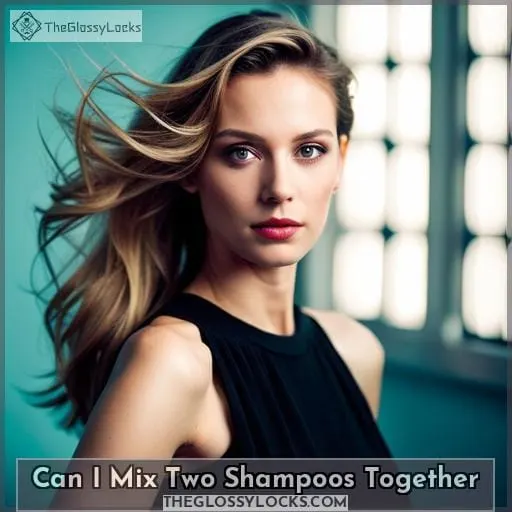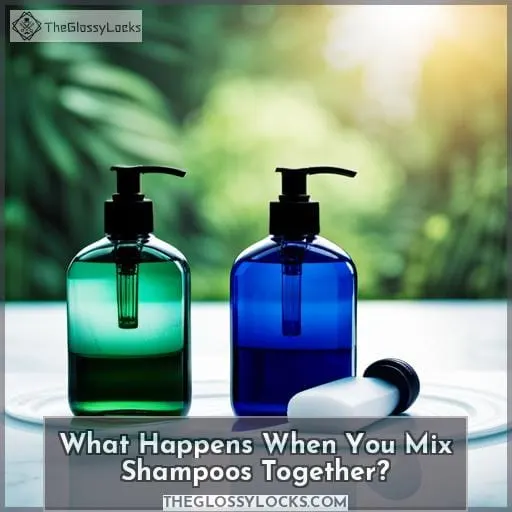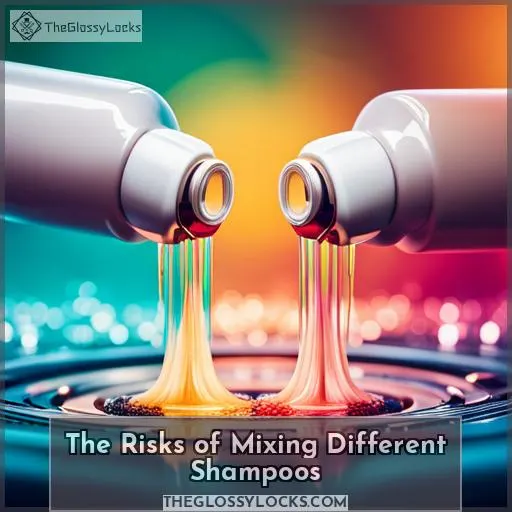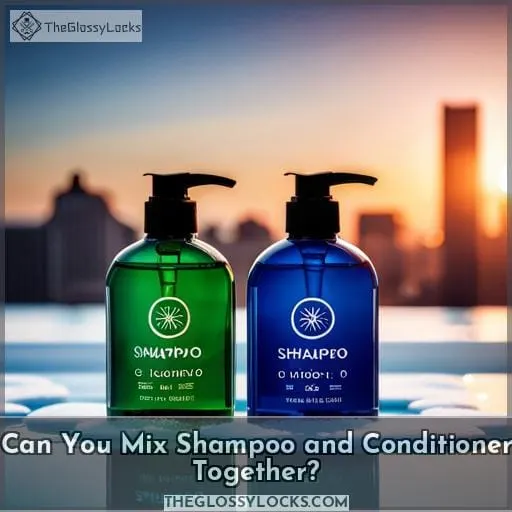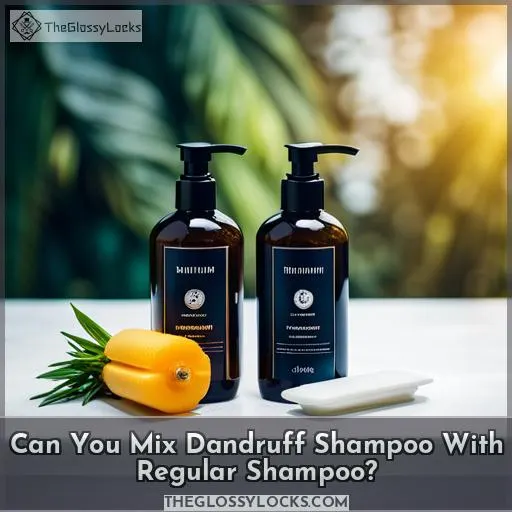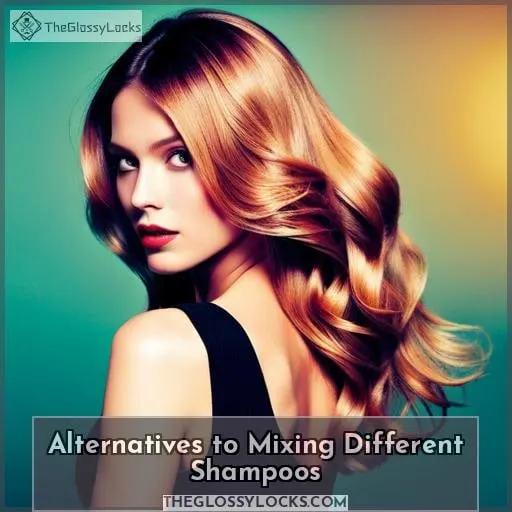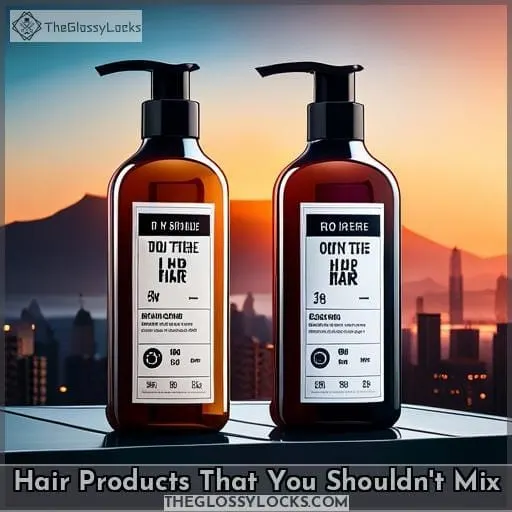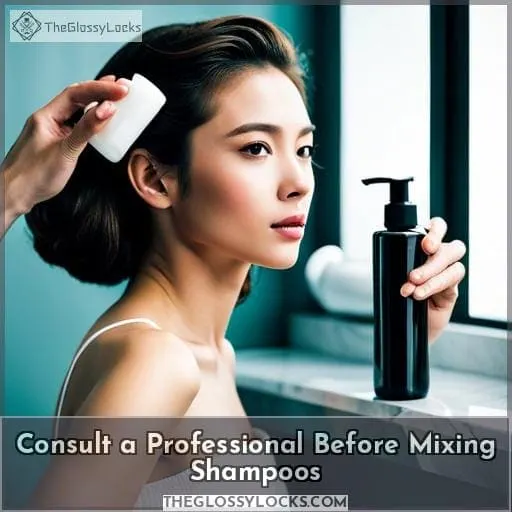This site is supported by our readers. We may earn a commission, at no cost to you, if you purchase through links.
Do you ever feel like your shower is just a little too crowded? With all those different bottles of shampoo, conditioner, body wash, and face wash, it can be hard to keep track. Have you ever been so desperate for space that you’ve considered mixing two products together into one? It might seem like an ingenious idea, but there are certain risks associated with combining bath products that must not be overlooked.
Before considering mixing any shampoos or conditioners together, take the time to learn about what could happen if done incorrectly. This article will provide useful information on how to mix two shampoos safely and effectively.
Table Of Contents
- Key Takeaways
- What Happens When You Mix Shampoos Together?
- The Risks of Mixing Different Shampoos
- Can You Mix Shampoo and Conditioner Together?
- Can You Mix Dandruff Shampoo With Regular Shampoo?
- Alternatives to Mixing Different Shampoos
- Hair Products That You Shouldn’t Mix
- Consult a Professional Before Mixing Shampoos
- Frequently Asked Questions (FAQs)
- Conclusion
Key Takeaways
- Mixing different shampoos can have serious consequences on hair and scalp health, as different formulas are designed for different hair types and have a certain pH balance that shouldn’t be messed with.
- Combining two shampoos can strip natural oils from strands, leaving them dry and unmanageable, and can also lead to scalp irritation, dandruff, and even hair loss.
- Mixing two conditioners can cancel out their effects and lead to disappointment, but there is more opportunity for experimentation with caution.
- Dandruff-specific products and bath products should only ever be used alone, and be wary of mixing products without understanding their intended purposes and potential effects on pH balance. Stick with one product for best results and consult a professional if you want to mix products safely.
What Happens When You Mix Shampoos Together?
You may be tempted to mix two shampoos together, but it’s important to know the potential risks before doing so. Different hair types require different formulas, and mixing them could be counterproductive.
Furthermore, shampoo has a certain pH balance that shouldn’t be messed with, as a healthy scalp environment is crucial for preventing hair loss, and poor scalp health can lead to inflammation, which directly impacts hair follicles, as seen in a scalp health study, as this can lead to scalp irritation or even hair loss if you’re not careful.
It is also worth noting that blending two shampoos can strip your natural oils from your strands, leaving them dry and unmanageable – so proceed with caution!
Mixing shampoo with conditioner is usually not recommended either; they are designed for different purposes, after all! However, combining certain conditioners could bring out beneficial results depending on how it’s done correctly – just make sure you consult a professional beforehand to ensure safety, of course.
When it comes to dandruff-specific products, however, these should only ever be used alone since their active ingredients have been formulated specifically for treating dandruff-related issues. Never mix them in combination with other regular products unless otherwise advised by an expert firsthand.
2-in-1 shampoos are another one of those things which people often get wrong when mixing because the clash between their respective ingredients creates a less than ideal result overall. Instead, stick to using each product individually as per instructions given on their labels accordingly (especially sulfate-free ones!).
If you’re someone who loves experimenting with new products, then go ahead – just remember that trial and error might mean causing more harm than good in some instances too, though! For maximum effect, always try sticking solely within one range whenever possible rather than opting for any kind of mixture involving several elements at once.
The Risks of Mixing Different Shampoos
Mixing different shampoos can have serious consequences on your hair and scalp health. It is important to understand how pH balance, hair damage, and scalp irritation can all be affected by combining two shampoo products.
While it may seem like a harmless solution for trying something new or creating the perfect product combination for you, doing so without understanding the risks could cause long-term problems that are difficult to fix.
PH Balance
Be wary when considering mixing bath products, as the pH balance of shampoo can easily be thrown off by combining two formulas. This disruption in the scalp’s delicate balance can lead to irritation and oil stripping from hair, leaving it dry and unmanageable.
Professional advice should always be sought before attempting any combination of shampoos or conditioners. Leah Loves Hair is a great resource for finding information on hair products that are safe to work together.
Products such as body washes may have different formulas but will usually contain lauryl sulfate, so they shouldn’t be mixed without consulting a professional first. Different shampoos are formulated for different scalp types, so mixing them could yield unpredictable results, even when using similar brands.
Consider all factors carefully before proceeding with any mix-and-match plan, regardless of your goal, whether it’s cost savings or creating an ideal blend for your particular needs.
Hair Damage
Mixing two shampoos can have damaging effects on your hair, such as scalp irritation, dandruff, and even hair loss. The wrong combination of shampoos could strip away natural oils from the scalp and leave it dry or unmanageable.
Dandruff treatments should not be mixed with regular shampoo as they contain different ingredients that may disrupt the delicate pH balance of the scalp. Similarly, combining face washes with shampoo can also cause harm due to their unique formulas designed for specific purposes.
Although mixing two products together has potential benefits like cost savings or creating your own unique shampoo mix, there are risks associated with using incompatible combinations of conditioners and shampoos.
Even when considering sulfate-containing shampoos specifically created for oily scalps or thick hair types, combine them cautiously since their interaction might counteract each other’s effectiveness by cancelling out all properties beneficial to you personally!
Additionally, depending on what type of oils you’re using within your haircare routine, this too must be taken into consideration before deciding upon any kind of new product combination trial run.
Scalp Irritation
Before attempting to combine two shampoos, be aware that it could lead to scalp irritation and other unpleasant effects. Combining shampoo with the wrong conditioner can cause your scalp’s pH balance to be disrupted, leading to dryness or even dandruff.
Hair oils may also become stripped away if you mix incompatible products together, resulting in a dull appearance and unmanageable hair.
Dandruff prevention is key when it comes to maintaining healthy scalps, but mixing two different shampoos might not provide the desired results for everyone as this method has not been proven scientifically yet.
So take extra precaution when combining any bath product. Do research on ingredients beforehand and make sure they work well together before using them!
Can You Mix Shampoo and Conditioner Together?
Now, let’s move on to the question of whether you can mix shampoo and conditioner together. Many people think it’s safe to do so, but there are a few things to consider before mixing these two products.
First off, different types of shampoos and conditioners are designed for specific hair types like curly or straight hair; mixing them could be counterproductive if they’re not compatible with each other.
Additionally, it’s important to check if the shampoo is sulfate-free since sulfates can strip natural oils from your scalp and cause dryness or irritation when mixed with a regular shampoo.
Also, be aware that combining two opposing formulas (like dandruff shampoo with regular) could result in an unpleasant feeling due to conflicting pH levels—so proceed cautiously!
When deciding whether or not you should mix your shampoos/conditioners together, keep in mind that most experts advise against this practice as they believe doing so will negate any positive effects each product was formulated for individually.
However, some people still prefer experimenting by blending their own concoction at home; just remember that while trial & error is always encouraged when beauty comes into play – safety first must remain top priority!
Can You Mix Dandruff Shampoo With Regular Shampoo?
It’s worth taking extra precautions when combining different types of shampoos, like dandruff shampoo and regular shampoo. Mixing two opposing products can do more harm than good in the long run, so it’s important to check the labels before buying two products to ensure they are fit to be used in combination.
Here are a few points that you should consider before mixing:
- Dandruff Solutions: Different shampoos are formulated for different hair types, and using two at once could be counterproductive or damaging. Consult with a dermatologist or hairstylist beforehand if you’re considering mixing dandruff solutions together with regular shampoo.
- Scalp Balance: The scalp has its own delicate balance, which shouldn’t be messed with by using multiple treatments at once. So, stick to one product whenever possible for best results. Avoid 2-in-1 shampoos as these can risk damaging hair due to the clash of ingredients and pH levels between them both.
- Hair Types: Different hair textures require their own specific care, so find out what works best for your type of locks instead of trying an experiment that may not work out well in the end.
- Sulfate Free/pH Levels: Check if either product is sulfate-free before combining them together as this will affect how each formula works on your strands, especially regarding pH levels.
Mixing any bath products without understanding their intended purposes first can lead down a slippery slope towards damaged tresses. Proceed cautiously! It may seem like fun experimenting, but it’s always better to be safe than sorry when dealing with such powerful formulas meant specifically designed for certain needs.
Even though some people claim beneficial results from doing so, there is no solid proof backing up this method yet! Stick within categories (like body washes) where all components have a similar composition rather than crossing over into other realms (such as face washes).
In order to get the just-right mix ratio between moisturizing properties and cleansing agents, try finding special formulas made exactly tailored towards those goals.
Alternatives to Mixing Different Shampoos
You may be wondering if it is possible to mix two different shampoos together. While this is not recommended, there are alternative solutions for getting the last few drops out of your bottles or trying a two-in-one product.
You will want to make sure that you understand all of the benefits and drawbacks associated with these options before making any decisions about what shampoo will work best for you and your hair care needs.
Getting the Last Few Drops
You may find yourself wanting to get the last few drops from a bottle of shampoo or conditioner. However, it’s important to remember that mixing two shampoos together can be risky and should always be done with caution.
Instead of combining products, try experimenting safely with sulfate-free options that won’t disrupt your scalp balance or damage hair types.
Check product labels for specific instructions on usage and stick with one shampoo at a time to enjoy its unique benefits. When it comes to body washes, they are generally straightforward in composition and can be mixed more easily than other bath products like face washes, which vary greatly in their formulation.
If you’re looking for cost savings without sacrificing quality results, consider using every drop by flipping your shampoo bottle upside down or adding water into the mix instead of risking potential harm through mixing different formulas together.
Two-in-One Products
Try combining two products for a unique result – just be aware of the potential risks! Mixing two shampoos together can have some benefits, but it also carries certain risks. The age-old question of whether you should mix different combinations has been debated by many, including chief editors and staff writers alike.
For those who are space-economical or simply want to experiment with new product concoctions, mixing shampoo could yield beneficial results if done correctly. However, caution is needed as it could cause scalp imbalance and damage hair types due to differing pH levels in each formula.
It’s important to check that both shampoos are sulfate-free before attempting this method; otherwise, it may strip natural oils from your hair, leaving it dry and unmanageable.
Ultimately, this practice is risky, so proceed with caution when experimenting with different combinations and consult a professional if necessary!
Hair Products That You Shouldn’t Mix
Mixing two shampoos together may seem like a good idea, but it can be very risky. Different hair types require different products, and mixing the wrong combination could leave your hair dry, damaged, or worse.
It’s important to consider that shampoo has certain pH levels that should not be messed with. If you are considering combining two shampoos, consult a professional hairstylist or dermatologist for advice before taking any action, as the risks may outweigh the benefits in some cases.
Furthermore, if you are looking at 2-in-1 shampoos, they may contain acne-fighting ingredients that could interact negatively with other products when mixed together.
When it comes to conditioners, there is more of an opportunity for experimentation as long as caution is taken. However, even then, mixing two conditioners can still cancel out their effects and lead to disappointment.
To avoid this risk altogether, stick strictly to one shampoo and enjoy its unique benefits.
Lastly, remember that experimenting without consulting a professional first might result in undesired results.
Consult a Professional Before Mixing Shampoos
It’s always wise to seek advice from a professional before combining two shampoos – after all, in this case, the saying ‘too much of a good thing’ still applies! Mixing two different products can have significant consequences on your hair and scalp.
- pH Balance – Shampoo is formulated with a certain pH balance that shouldn’t be messed with. If combined incorrectly, it could strip natural oils from the hair and leave it dry or unmanageable.
- Hair Damage – Using two opposing conditioners or 2-in-1 product combinations can cancel out their effects as well as damage your hair by overloading ingredients not made to work together.
- Scalp Irritation – Combining wrong formulas may also cause irritation leading to dandruff flakes, redness, itchiness, and even loss of strands due to breakage or thinning out of the follicles.
The founders at Hair Everyday recommend considering your hair type and scalp conditions, such as those requiring sulfate-free options, before mixing shampoos for any reason—it’s just a safer option! Besides being a much safer option than experimenting blindly, consulting someone who understands how these products interact will give you access to more attractive options tailored specifically for your needs.
Plus, they’ll know what possible risks are involved in combining particular formulas, so there is no guesswork involved! For these reasons alone, getting professional help makes good sense.
Frequently Asked Questions (FAQs)
Should I use two different shampoos at the same time?
Using two different shampoos at the same time isn’t recommended. Mixing them could cause an interaction between the formulas, disrupting your scalp’s delicate balance and potentially leading to irritation, dandruff, or hair loss.
Stick with one product for best results; consult a professional if you want to mix products safely.
Is it safe to mix two shampoos together?
Mixing two shampoos can be risky as they are formulated for different hair types, and their ingredients may not react well together. However, with caution and proper guidance from a professional, it can lead to beneficial results.
What are the benefits of mixing two shampoos?
Mixing two shampoos can offer numerous benefits, such as customizing a formula for your hair type and balancing pH levels. However, it is crucial not to take the potential risks lightly – it is best to consult a professional before attempting any such mixing.
Are there any potential side effects of mixing two shampoos?
Mixing two shampoos could strip natural oils, cause scalp irritation and dandruff, and even lead to hair loss. Therefore, it’s best to tread lightly and stick with one shampoo to reap the unique benefits it offers.
If you want to combine products for maximum results, it’s recommended to consult a professional.
Is it necessary to consult a professional before mixing shampoos?
It is advisable to consult a professional before considering mixing shampoos. Various formulas and pH levels may interact in ways that are harmful or counterproductive, potentially causing irritation, dandruff, or hair loss.
It is better to err on the side of caution and stick to using one shampoo for optimal results.
Conclusion
Mixing two shampoos together can be a risky practice, as it can lead to scalp irritation, dandruff, and hair damage. It can also disrupt the pH balance of the scalp and strip natural oils from hair. Therefore, it’s best to consult a professional before attempting to mix two shampoos.
Do you know what ingredients are in the products you’re using? Can you be sure that they won’t interact in an unwelcome way? Rhetorical questions like these can help you make an informed decision. Ultimately, sticking to one shampoo is usually the safest bet for achieving the best results.

